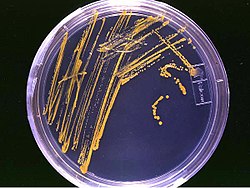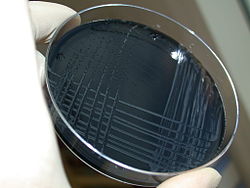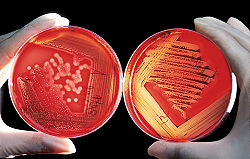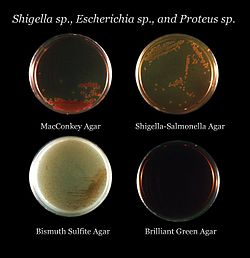Growth medium
|
Read other articles:

Запрос «Пугачёва» перенаправляется сюда; см. также другие значения. Алла Пугачёва На фестивале «Славянский базар в Витебске», 2016 год Основная информация Полное имя Алла Борисовна Пугачёва Дата рождения 15 апреля 1949(1949-04-15) (75 лет) Место рождения Москва, СССР[1] �…

この記事は検証可能な参考文献や出典が全く示されていないか、不十分です。出典を追加して記事の信頼性向上にご協力ください。(このテンプレートの使い方)出典検索?: コルク – ニュース · 書籍 · スカラー · CiNii · J-STAGE · NDL · dlib.jp · ジャパンサーチ · TWL(2017年4月) コルクを打ち抜いて作った瓶の栓 コルク(木栓、蘭&…

Cet article est une ébauche concernant l’Algérie. Vous pouvez partager vos connaissances en l’améliorant (comment ?) selon les recommandations des projets correspondants. Bordj Moulay HassanFort l'Empereur (fr)سلطان قلعهسى (ota) Bordj Moulay Hassan au XIXe siècle Localisation Pays Algérie Wilaya Alger Commune El Biar Coordonnées 36° 46′ 25″ nord, 3° 02′ 45″ est Géolocalisation sur la carte : Alger Bordj Moulay Hassan…

Marie AntoinetteLukisan oleh Élisabeth Vigée Le Brun, 1785Permaisuri Kerajaan Prancis dan NavarraPeriode10 Mei 1774 – 4 September 1791Permaisuri PrancisPeriode4 September 1791 – 10 Agustus 1792Informasi pribadiKelahiran(1755-11-02)2 November 1755Istana Hofburg, Vienna, AustriaKematian16 Oktober 1793(1793-10-16) (umur 37)Place de la Révolution, Paris, PrancisPemakaman21 Januari 1815Basilika St DenisWangsaHabsburg-LorraineNama lengkapJerman: Maria Antonia Josepha Johannacode: de is dep…

The Right HonourableThe Viscount RidleyDL FRSL FMedSciRidley pada 2018 Anggota Dewan Bangsawan Bangsawan TemporalPetahanaMulai menjabat 13 Februari 2013PendahuluThe 13th Earl FerrersPenggantiPetahanaKetua Northern RockMasa jabatanApril 2004 – Oktober 2007PendahuluSir John RiddellPenggantiBryan Sanderson Informasi pribadiLahirMatthew White Ridley7 Februari 1958 (umur 66)Northumberland, InggrisPartai politikConservativeSuami/istriAnya Hurlbert (m. 19…
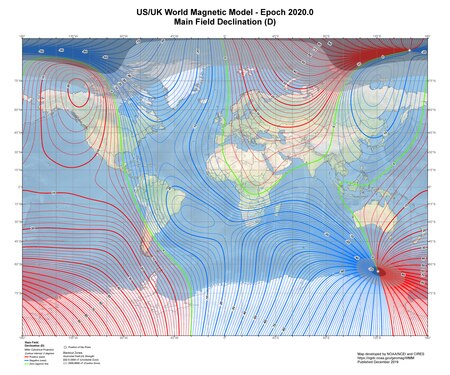
Angle on the horizontal plane between magnetic north and true north Example of magnetic declination showing a compass needle with a positive (or easterly) variation from geographic north. Ng is geographic or true north, Nm is magnetic north, and δ is magnetic declination. Magnetic declination (also called magnetic variation) is the angle between magnetic north and true north at a particular location on the Earth's surface. The angle can change over time due to polar wandering. Magnetic north is…

Society of the Institute of Electrical and Electronics Engineers This article relies excessively on references to primary sources. Please improve this article by adding secondary or tertiary sources. Find sources: IEEE Signal Processing Society – news · newspapers · books · scholar · JSTOR (January 2020) (Learn how and when to remove this message) The IEEE Signal Processing Society (IEEE SPS) is one of the nearly 40 technical societies of the Institute of…

Державний комітет телебачення і радіомовлення України (Держкомтелерадіо) Приміщення комітетуЗагальна інформаціяКраїна УкраїнаДата створення 2003Керівне відомство Кабінет Міністрів УкраїниРічний бюджет 1 964 898 500 ₴[1]Голова Олег НаливайкоПідвідомчі орг�…

The La Paz Sand Dunes in December 2019 Camping at La Paz Sand Dunes in 2015 The La Paz Sand Dunes is an 85-square-kilometer (33 sq mi) protected sandy coastal desert and beach located in Laoag, Ilocos Norte, in the Philippines. The area is popular for recreational activities such as sandboarding and 4x4 vehicle riding.[1] 4x4 riders at La Paz Sand Dunes in 2015 References ^ Sandboarding in the Philippines. Sand-boarding.com. Retrieved 10 June 2021. vtePhilippines articlesH…

Local football club in the Horsham District Football League, Australia An editor has performed a search and found that sufficient sources exist to establish the subject's notability. Please help improve this article by adding citations to reliable sources. Unsourced material may be challenged and removed.Find sources: Harrow Balmoral Football Netball Club – news · newspapers · books · scholar · JSTOR (September 2023) (Learn how and when to remove this mes…

Entrance to La Boqueria Fruits and vegetables for sale at La Boqueria The Mercat de Sant Josep de la Boqueria (Catalan: [məɾˈkad də ˈsaɲ ʒuˈzɛb də lə βukəˈɾi.ə]; Spanish: Mercado de San José de la Boquería), usually simply referred to as La Boqueria, is a large public market in the Ciutat Vella district of Barcelona, Catalonia, Spain, and one of the city's foremost tourist landmarks, with an entrance from La Rambla, not far from the Liceu, Barcelona's opera house. The m…

German-born American economist (1789–1846) Friedrich ListLithography of List by Josef Kriehuber, 1845BornDaniel Friedrich List(1789-08-06)6 August 1789Reutlingen, Duchy of Württemberg, Holy Roman Empire of the German NationDied30 November 1846(1846-11-30) (aged 57)Kufstein, County of Tyrol, Austrian Empire, German ConfederationNationalityGermanAcademic careerFieldEconomicsSchool ortraditionHistorical SchoolInfluencesJean-Antoine Chaptal · Alexander Hamilton · Daniel Raymond · Ado…
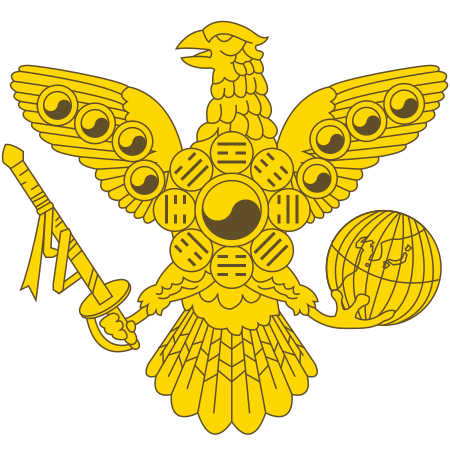
Monarchy in East Asia (1897–1910) Empire of Korea대한제국 (Korean)大韓帝國Daehan Jeguk (RR)Taehan Cheguk (MR)1897–1910 Flag Imperial Seal Motto: 광명천지光明天地Illuminate Heaven and EarthAnthem: 대한제국 애국가大韓帝國愛國歌Patriotic Hymn of the Great Korean Empire (1902–1910)National seal:大韓國璽Emblem:Territory of the Korean Empire 1903–1905. The disputed Gando and Samjiyon regions are shaded in lighter green.StatusSovereign …
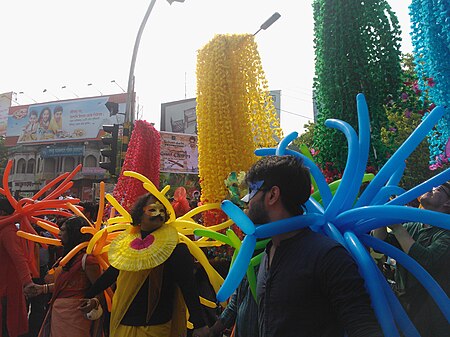
LGBT rights in BangladeshBangladeshStatusIllegal since 1862 under Section 377 of the Bangladeshi Penal Code[1]PenaltyImprisonment for same-sex sexual activity.[2]Gender identityThird gender recognized;[3][4] transgender persons permitted to officially register their identity as this gender[5][6]Discrimination protectionsNoFamily rightsRecognition of relationshipsNoAdoptionNo Lesbian, gay, bisexual, and transgender (LGBT) people in Bangladesh face w…

معرض بغداد الدولي إحداثيات 33°18′53″N 44°21′55″E / 33.314804965719°N 44.365142810432°E / 33.314804965719; 44.365142810432 معلومات عامة الموقع المنصور العنوان شارع دمشق، بغداد القرية أو المدينة بغداد الدولة العراق معلومات أخرى تعديل مصدري - تعديل معرض بغداد الدولي هو أرض حكومية تابع…

TongaNickname(s)Tonga TalaAssociationTonga Netball AssociationConfederationOceania Netball FederationWorld ranking8 Team colours Netball World CupAppearances22015 placing8thBest result8th (2023) The Tonga national netball team (Tongan: timi netipolo fakafonua ʻa Tonga) represents Tonga in international women's netball. Although netball has been played in Tonga, they joined the International Netball Federation in 2011.[1][2] Tonga won bronze at the South Pacific Games in 1983, 19…

Astronautics Corporation of AmericaCompany typePrivateIndustryAerospace and defenseFounded1959 Milwaukee, WIHeadquartersOak Creek, Wisconsin, USAKey peopleNathaniel K. Zelazo, FounderNorma Z. Paige, FounderDr. Ronald E. Zelazo, CEOStephen Givant, CFOProductsCommercial avionicsMilitary avionics Space systemsCybersecurityNumber of employees1,800SubsidiariesKearfott CorporationAstronautics C.A. Ltd.WebsiteAstronautics.com Astronautics Corporation of America (ACA) was established in 1959 and is a US…

Ne doit pas être confondue avec la maison d'arrêt de Versailles Prison des Chantiers Des femmes de la Commune, photomontage des détenues de la prison des Chantiers. Ernest-Charles Appert, 1872, musée Carnavalet, Paris. Localisation Pays France Région Île-de-France Département Yvelines Localité Versailles Quartier Chantiers Coordonnées 48° 47′ 49″ nord, 2° 08′ 04″ est Géolocalisation sur la carte : Versailles Prison des Chantiers Géolocalisa…

Putri Haya bint Husseinالأميرة هيا بنت الحسينPrincess Haya (right) congratulating FEI 2012 award winner Courtney King-DyeKelahiran3 Mei 1974 (umur 50)Amman, YordaniaWangsaHashemite (melalui kelahiran) Wangsa Al-Falasi (melalui pernikahan)AyahHussein dari YordaniaIbuAlia al-HusseinPasanganMohammed bin Rashid Al MaktoumAnakSheikha Al JalilaSheikh Zayed Putri Haya bint Hussein (bahasa Arab: الأميرة هيا بنت الحسين; kelahiran 3 Mei 1974) adalah putri dar…

Not to be confused with TriMet. A Trambaix station, Francesc Macià. Tramvia Metropolità, SA (TramMet) is a company based in Barcelona, Catalonia, Spain. It's a joint venture of the companies FCC-Vivendi, COMSA, Acciona-Necso, Alstom, Sarbus, Soler&Sauret, Banc Sabadell and Société Générale. It was created in 1999 to operate the new tram systems in Barcelona, Trambaix and Trambesòs from April 27, 2000. The Trambaix network was inaugurated on April 3, 2004, whereas the inauguration of T…
